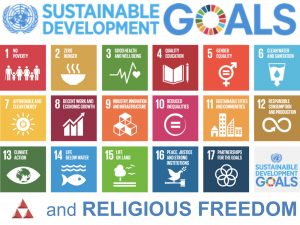 UPDATED 29 Sept. 2015: New report challenges myth of religious violence. The research found no general causal relationship between religion and conflict when looking at all of the current conflicts in the world.
UPDATED 29 Sept. 2015: New report challenges myth of religious violence. The research found no general causal relationship between religion and conflict when looking at all of the current conflicts in the world.
Countries with greater religious freedoms are generally more peaceful, whereas countries with less religious freedom are generally less peaceful.
The most influential factor affecting religious freedom is the government type. Full democracies are the most peaceful and have the greatest level of religious freedom, regardless of the type of religious belief or various religious characteristics.
This report presents empirical research conducted by the Institute for Economics and Peace (IEP) in conjunction with the Religious Freedom & Business Foundation that aims to get beyond ideology to provide a more comprehensive understanding of how religion interacts with peace.
Quantitative analysis has revealed that many of the commonly made statements surrounding the relationship between peace and religion are not supported by the analysis contained in this study.
This report answers five common questions relating to religion and violence. To determine the list of questions the most common themes of discussion and opinions expressed in the media were identified.
QUESTION 1
IS RELIGION THE MAIN CAUSE OF CONFLICT TODAY?
Religion is not the main cause of conflicts today. Whilst religion has evidently been a cause of many conflicts throughout history it is by no means the only reason for conflict. Surveying the state of 35 armed conflicts from 2013, religious elements did not play a role in 14, or 40 per cent.
QUESTION 2
DOES THE PROPORTION OF RELIGIOUS BELIEF OR ATHEISM IN A COUNTRY DETERMINE THE PEACE OF THE COUNTRY?
There is no clear statistical relationship between either the presence or the absence of religious belief and conflict. Even at the extremes, the least peaceful countries are not necessarily the most religious and vice versa. For example, when looking at the ten most peaceful countries three would be described as highly religious, and when looking at the ten least peaceful nations two would be described as the least religious.
Conversely, the absence of religious belief, as manifested by atheism, also sees no significant link to broader societal peacefulness.
QUESTION 3
IN MUSLIM COUNTRIES, DOES THE DEMOGRAPHIC SPREAD OF SUNNI AND SHIA DETERMINE PEACE?
Despite the apparent role of Sunni and Shia sectarian violence in parts of the Middle East today, when reviewed globally, countries with high proportions of Sunni and Shia are not necessarily violent or plagued with conflict. What distinguishes Muslim-majority countries is differing performance in the Pillars of Peace, a framework developed by IEP to assess the positive peace factors that create peaceful societies. Specifically, countries that have lower corruption, well-functioning government and better relations with neighbours are more peaceful regardless of the particular levels of Sunni and Shia.This report acknowledges the sectarian violence between Sunni and Shia that is a major feature of conflicts in the Middle East today, but highlights that Sunni and Shia conflicts are not inevitable. Although there are numerous religious divides, the paper focuses on the Sunni and Shia divide due to the high profile it is currently receiving in the media.
QUESTION 4
IS RELIGION KEY TO UNDERSTANDING WHAT DRIVES PEACE?
There are many other socio-economic characteristics that have more significant explanatory power in understanding why conflict and peace occurs than religion does. There are however some religious factors that are significantly related to peace.
Multivariate regression analysis reveals that there is a consistent relationship between factors such as corruption, political terror, gender and economic inequality and political instability which determine poor peace scores as measured by the Global Peace Index (GPI). The research clearly indicates that these factors are globally more significant determinants in driving violence and conflict in society than the presence of religious belief.
Nevertheless, there are two religious characteristics which are associated with peace; restrictions on religious behaviour as well as hostilities towards religion. Countries without a dominant religious group are, on average, more peaceful and have less restrictions or social hostilities around religion than countries with a dominant religious group. However, government type has much greater explanatory power than religion in understanding differing levels of peace.
QUESTION 5
CAN RELIGION PLAY A POSITIVE ROLE IN PEACEBUILDING?
While a lot of analysis may focus on the negative role of religion it is important to acknowledge the potential positive role of religion in peacebuilding through inter-faith dialogue and other religiously-motivated movements. It was found that countries that had higher membership of religious groups tended to be slightly more peaceful.
Religion can be the motivator or catalyst for bringing about peace through ending conflict as well as helping to build strong social cohesion. Furthermore, religion can act as a form of social cohesion and, like membership of other groups, greater involvement in society can strengthen the bonds between citizens strengthening the bonds of peace.
 The new study also furthers previous work in the field, including The Price of Freedom Denied (by Brian Grim & Roger Finke, Cambridge, 2011). Grim & Finke’s research showed that religious freedom is a key ingredient to peace and stability, as measured by the absence of violent religious persecution and conflict.
The new study also furthers previous work in the field, including The Price of Freedom Denied (by Brian Grim & Roger Finke, Cambridge, 2011). Grim & Finke’s research showed that religious freedom is a key ingredient to peace and stability, as measured by the absence of violent religious persecution and conflict.




